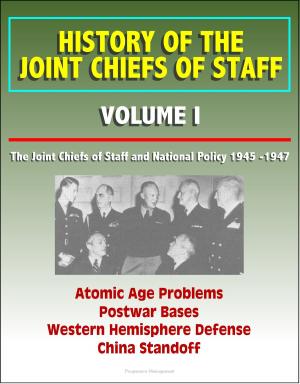The Vital Link: The Tanker's Role in Winning America's Wars: History of Air Refueling from Vietnam to Desert Storm, KC-135, KC-10, Force Structure, The Family that Trains Together, Fights Together
Nonfiction, History, Military, Weapons, Aviation| Author: | Progressive Management | ISBN: | 9781370741823 |
| Publisher: | Progressive Management | Publication: | September 17, 2016 |
| Imprint: | Smashwords Edition | Language: | English |
| Author: | Progressive Management |
| ISBN: | 9781370741823 |
| Publisher: | Progressive Management |
| Publication: | September 17, 2016 |
| Imprint: | Smashwords Edition |
| Language: | English |
This excellent report has been professionally converted for accurate flowing-text e-book format reproduction. This paper focuses on the unique and vital capabilities of the US Air Force's KC-135 tanker fleet. Specifically, historic and current tanker usage, tanker operational employment, and the capability of today's tanker fleet are analyzed, with emphasis on force structure and force management. Given that the KC-135 is the USAF's primary air refueling asset and that no planned replacements are due on the flightline for some time, how can the current KC-135 method of employment and force structure support future DOD and coalition operations?
Since its inception in the mid-1950s, the KC-135 has undergone numerous configuration as well as mission changes. One constant throughout has been the reliance of the nation's airpower on this critical asset, whether it was sitting alert during the cold war, or providing mission essential fuel for F-117s en route to Baghdad during the Gulf War.
The success of combat operations in Operation Allied Force was made possible due to the rapid, massive, and professional employment of the KC-135 in the theater of operations. This success, however, can be attributed more to the actions of the tanker community than to any planned, deliberate inclusion of air refueling assets into the operations plan.
In light of decreasing budgets, aging airframes, increased downtime for maintenance, and an explosion in the operations tempo, this paper proposes a four-pronged methodology addressing tanker vision, organization, training, and employment, as the correction needed to get the KC-135 weapon system back on centerline. This will allow the tanker to effectively aid the Air Force in successfully deterring conflict and if needed, quickly win the nation's future wars.
CHAPTER 1 - INTRODUCTION * Notes * CHAPTER 2 - STRATOTANKER HISTORY: COLD WAR TO DESERT HEAT * The Tanker Goes Tactical: Vietnam * Refueling across a Line in the Sand: Desert Storm * Notes * CHAPTER 3 - AGING TANKERS COME OF AGE: RECENT TANKER EXPERIENCE * Velocity Equals Distance over Time * Damn the Boneyard: Full Speed Ahead! * Allied Force: The Tanker Shines * Notes * CHAPTER 4 - KC-135 FORCE STRUCTURE: WHEN TO SAY WHEN * The Monsters under the Bed * "We interrupt this program" * On the Horizon * Notes * CHAPTER 5 - "VOTE" FOR AIR REFUELING * If It IS Broken * VOTE Early and Often * I Can See Clearly Now . . Or Can I? * Train Like You Fight * The Family that Trains Together, Fights Together * VOTE Yes! * Notes * CHAPTER 6 - CONCLUSIONS * Where to, Mister? * Notes
This excellent report has been professionally converted for accurate flowing-text e-book format reproduction. This paper focuses on the unique and vital capabilities of the US Air Force's KC-135 tanker fleet. Specifically, historic and current tanker usage, tanker operational employment, and the capability of today's tanker fleet are analyzed, with emphasis on force structure and force management. Given that the KC-135 is the USAF's primary air refueling asset and that no planned replacements are due on the flightline for some time, how can the current KC-135 method of employment and force structure support future DOD and coalition operations?
Since its inception in the mid-1950s, the KC-135 has undergone numerous configuration as well as mission changes. One constant throughout has been the reliance of the nation's airpower on this critical asset, whether it was sitting alert during the cold war, or providing mission essential fuel for F-117s en route to Baghdad during the Gulf War.
The success of combat operations in Operation Allied Force was made possible due to the rapid, massive, and professional employment of the KC-135 in the theater of operations. This success, however, can be attributed more to the actions of the tanker community than to any planned, deliberate inclusion of air refueling assets into the operations plan.
In light of decreasing budgets, aging airframes, increased downtime for maintenance, and an explosion in the operations tempo, this paper proposes a four-pronged methodology addressing tanker vision, organization, training, and employment, as the correction needed to get the KC-135 weapon system back on centerline. This will allow the tanker to effectively aid the Air Force in successfully deterring conflict and if needed, quickly win the nation's future wars.
CHAPTER 1 - INTRODUCTION * Notes * CHAPTER 2 - STRATOTANKER HISTORY: COLD WAR TO DESERT HEAT * The Tanker Goes Tactical: Vietnam * Refueling across a Line in the Sand: Desert Storm * Notes * CHAPTER 3 - AGING TANKERS COME OF AGE: RECENT TANKER EXPERIENCE * Velocity Equals Distance over Time * Damn the Boneyard: Full Speed Ahead! * Allied Force: The Tanker Shines * Notes * CHAPTER 4 - KC-135 FORCE STRUCTURE: WHEN TO SAY WHEN * The Monsters under the Bed * "We interrupt this program" * On the Horizon * Notes * CHAPTER 5 - "VOTE" FOR AIR REFUELING * If It IS Broken * VOTE Early and Often * I Can See Clearly Now . . Or Can I? * Train Like You Fight * The Family that Trains Together, Fights Together * VOTE Yes! * Notes * CHAPTER 6 - CONCLUSIONS * Where to, Mister? * Notes















